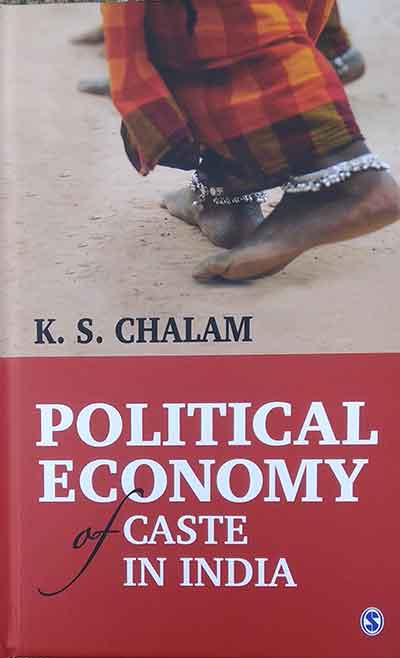
Caste plays a role at every stage of an Indian’s economic life: in school, university, the labor market, and into old age. The influence of caste extends beyond private economic activity into the public sphere, where caste politics determines access to public resources. Sure, there has been a convergence in education, occupations, income, and access to public resources across caste groups in the decades after independence. Some of these have come in the form of affirmative action. But much remains to be done and undone. It is important to understand the positive and negative consequences of caste engrossment across a variety of spheres in the Indian economy. Economics can’t be separated from caste. They are intertwined to a very large extent. There can’t be different opinions that with economic development, all caste discriminations and complexes will die away eventually.
The present book ‘Political Economy of Caste in India ‘by Dr. KS Chalam is an important book to understand India’s caste dynamics. As the blurb says: it ‘presents the caste mode of production as an important analytical tool to understand the socio-economic and political dynamics of India.’
A well-known political economist and educationist, and a former member of the Union Public Service Commission Dr. Chalam has been the Vice-Chancellor of the Dravidian University in Andhra Pradesh and had taught in the Department of Economics, Andhra University for about three decades. Founder of the Academic Staff College Scheme in the country, he was its first director.
Author of two earlier books ‘Caste-Based Reservations and Human Development in India’ and ‘Economic Reforms and Social Exclusion, this volume looks at caste from the economic base and also links it with the superstructure that includes the judiciary, untouchability practices, caste atrocities against Dalits, social exclusion and so on. Right now Chairman, Institute for Economic and Social Justice, what Dr Chalam suggest in the book is precisely this: the human rights perspective is one of the ways to combat caste.
Divided into thirteen chapters – Caste Mode of Production: Concept and Content, Colonial Approach to Hindutva and Marxist Writing, Caste and Economic Power in India, Inequity in the Development of Human Capital in India, Economic Deprivation and Social Exclusion of Marginalized Castes, New Economic Policy: The Dvija Project, Caste and the Advent of Crony Capitalism in India, Judiciary and Deprivation of Social Justice, Social Barriers as Impediments of Information Flow, Physical Alienation: Offences and Atrocities against Scheduled Castes, The Fragmented Assertion: Divide and Rule and Globalization, the Future of Dalits and Adivasis and Democracy Dalit Rights and the Paradigm Shift– the book’s reach is all-encompassing.
It presents empirical studies to show that the social habits of discrimination and crimes against the marginalized communities prevail even in the 21st century to physically alienate them from mainstream opportunities and ensure involuntarily supply of labor at lower wages. It enunciates that the economic intensity of caste can be distinguished through the caste mode of production. The study brings out the limitations of some of the Marxists’ understanding of caste. It also presents a distinct approach for comprehending caste in all its ramifications.
In the book, Dr. Chalam says how Independent India’s economic system fundamentally changed in 1991, under former Prime Minister Narasimha Rao’s New Economic Policy (NEP). However, he argues, in spite of all the much -talked about successes of the reforms, there is an overlooked aspect of India’s liberalization: the forces of production in such a system continues to be Dalit labor-power that is ranked zero.
According to the author, the social conditions of who eventually benefited from India’s reforms in 1991 were laid much before PV Narasimha Rao entered the Prime Minister’s office. Yet, the New Economic Policy could not change the conditions of work for people from Scheduled Castes, Scheduled Tribes, and Other Backward Classes.
Before Rao came in, India had the License Permit Raj, where a few powerful businesses and bureaucrats who owned the means of production shaped Indian industries and commerce. Liberalization was supposed to change that. But there is no difference between what we had earlier and what we witness at present.
Instead of a few companies or power brokers controlling resources, we have many more, whose growth and leadership is also defined by caste. Take the big tech companies which are run by Indians and have a strong presence in India. How many of these companies have top leadership from the SC-ST or even OBC? How is that despite affirmative action none of these communities visible in India’s lists of post-liberalization billionaires?
So, in essence, there has been no real fundamental shift or change for the better. The people who were economically marginalized earlier are doubly marginalized now as a result of liberalization. The author says that the New Economic Policy is also a smokescreen: it obscures the fact that the success of liberalization rests on the shoulders of an unchanging caste hierarchy, where some groups benefited, and the bottom-most were still kept out which only strengthened caste systems.
Therefore, the NEP did not change much about the base of the country–it just changed the superstructure. The base, where the lower half of the caste chain experience acute marginalization, is very much alive.
In his earlier book, Dr. Chalam provided a comprehensive assessment of the impact of caste-based reservation on human development in India as also the impact of caste-based reservations on the target groups while suggesting an alternative strategy of applying the democratic principle of caste-based reservation.
This book is a further portrayal of his argument. For those who want to have a ring-side view of India’s caste system vis-a-vis the political economy, this book is a must-read.
‘Political Economy of Caste in India’
Dr. KS Chalam
SAGE India
New Delhi
2020
Rs 1250
Bhaskar Parichha is a journalist
SIGN UP FOR COUNTERCURRENTS DAILY NEWSLETTER
















































